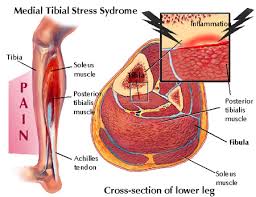Do you experience pain and discomfort in the leg from repetitive activity on hard surfaces, or due to forceful, excessive use of foot flextures?
You could be experiencing medial tibial stress syndrome (MTSS), or commonly known as “shin splints”. This injury is characterized by pain along the inside edge of the tibia (shin bone), which is the large bone in the lower part of the leg. Shin splints and other tibial injuries can be caused by repeated trauma to the tibia and the connective tissue surrounding the tibia through repetitive running activities or heavy plyometric jumping activities.
What causes shin splints?
Shin splints can usually be linked to overloading the muscles of the lower extremities with high mileage running programs, hard running surfaces, high impact activities (sprinting, jumping) or they can also be attributed to biomechanical and/or anatomical irregularities. If an athlete begins a running sport such as track and field or cross country and they end up running a lot of miles, jump too much, or at train at high intensities without progressing in their running or jumping program over a designated period of time, the overload of physical activity will put excess stress on the muscles, causing shin splints. Even if you have a progressive training program, muscle imbalances such as weak CORE muscles could cause shin splints injuries and inflexibility and tightness of the gastrocnemius and soleus may also contribute to shin splints as well.
Common Causes:
- Excessive pronation while running
- Engaging in excessive amounts of running, sprinting, and jumping activities
- Running, sprinting and jumping on hard surfaces
- Excessive outward rotation of foot while running
- Tight calf muscles

How can we treat shin splints?
Make sure you have an accurate diagnosis of shin splints in order to choose the most appropriate treatment. If you have a stress fracture, you will be required to rest until the bone is healed anywhere from (2-5 months). If addressing shin splints, the inflammation of soft tissue can be initially treated with rest, ice (reduce inflammation), NSAIDS (ibuprofen), and physical therapy.
What are ways to prevent shin splints?
Unfortunately there are no proven methods available to definitively prevent shin splints. There are several strategies, however, that may help in preventing shin splints. These strategies include wearing appropriate fitness shoes, warming up before engaging in recreational activities, gradually increasing activity so the body can adapt, discontinuing the activity if you start experiencing pain in the shins, keeping your body weight in check, and seeking the attention of a Physical Therapist before pain arises in order to assess your running or sport biomechanics.

Comments